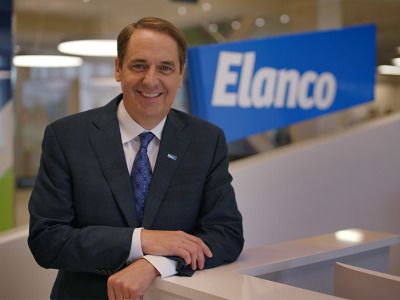The creation of the first inset carbon market offers a new revenue stream for dairy farmers that industry stakeholders hope will fuel continued innovation to reach agriculture's economic and environmental sustainability goals.
Three years ago, the dairy industry set its 2050 sustainability goal of being carbon neutral. Now, a new cloud-based livestock carbon inset market launched by Elanco Animal Health and Athian could help overcome a significant hurdle to accomplishing that goal by encouraging farmer adoption of new technologies.
“This isn’t going to be a little blip on the radar. This is going to do more in maybe two years than we’ve done in 25,” said Jeff Simmons, Elanco Animal Health's president and CEO.
Simmons and others believe all parts of the dairy production system could see emissions reduction through innovation.
Roughly one-third of the dairy sector's greenhouse gas emissions come from the animal itself through enteric methane emissions from the animals' gut. Another third comes from manure, including storage and application in the fields. Most of the remaining one-third comes from crop production, and about 5% comes from traditional energy use.
Athian CEO Paul Myer said his company establishes a protocol based on international greenhouse gas standards for each possible intervention and validates it by a certified third party. The first protocols created offer inset credits to producers who adopt specific manure management standards or utilize Elanco's feed additive Rumensin, which the company says will reduce enteric emissions by 5%. Another Elanco emissions-reducing feed additive — Bovaer — could be available in the first quarter when approved by the Food and Drug Administration.
 Jeff Simmons, Elanco Animal Health
Jeff Simmons, Elanco Animal Health
“Think of the protocol once it gets to the farmer as a cookbook. It’s got a recipe of how that should be implemented, and they’re verifying herd count, dry matter intake, the feed additive, all the key variables that you have to monitor for the effective use of the product according to the science and research behind it,” Myer said.
Elanco also developed UpLook, a digital platform for monitoring greenhouse gas emissions. Simmons said UpLook can integrate data already on each farm to provide information for third-party verification. Athian plans to integrate into different platforms and partner with other members of the livestock supply chain to expand its reach.
Farmers capturing greatest value
A challenge for companies is that producers have been overloaded with information about carbon markets in recent years, and still remain leery of getting involved. According to USDA, 92% of farmers are aware of carbon markets, but only 3% are participating in these markets. Through the new partnership, Elanco and Athian see a bridge between companies such as Danone, Nestle and General Mills and thousands of farmers within their supply chains working to improve environmental outcomes.
“Farmers take a wait-and-see attitude until somebody gets paid,” Myer said. “And now we can in good conscience say the marketplace is ready.”
For every credit that gets sold by Athian, the company keeps 25% of the value for administrative costs. Myer said the 75% value left in the hands of farmers is substantially higher than the average 40% that typically goes back to farms in an offset market.
“We realized that sustainability doesn’t work if farmers are not viable, and we’re anticipating that a farmer is going to get $25 per metric ton and up for any of these credits,” Myer said.
Athian also plans to pay producers every 30 days, another differentiator from the carbon sequestration offset markets with payments made only once a year — or sometimes years after actions are taken.
Myer believes 2024 will be the “breakout year” with the launching of five to 10 additional protocols on top of the four already in development. This would allow for as many as 50 producers to participate by the end of the year, expanding to hundreds by 2024. “Hopefully we’ll get to thousands by the tail end of next year.”
Companies have predominantly looked to offset markets — those outside their supply chains — to gain ground on reducing emissions when their own actions can’t do it alone. The inset market, by contrast, allows companies within the animal protein value chain the opportunity to use carbon credits that are verifiable and gain ground on meeting their scope 3 greenhouse gas reduction goals. Scope 3 emissions are those produced in a company's supply chain.
Myer said they’re already working with 20 off-take partners now and anticipate the first official partners to be announced before the end of the year.
“Our objective is to make this scale as quickly as possible so that it matches really the diversity of the dairy supply chain,” he said.
Jamie Jonker, chief science officer at the National Milk Producers Federation, sees the ability of dairy farmers to monetize the reductions as the linchpin of reaching the dairy industry’s 2050 sustainability goals.
It’s easy to be “in the know” about what’s happening in Washington, D.C. Sign up for a FREE month of Agri-Pulse news! Simply click here.
“We have some technologies available now, we have some things that are coming in the market in the not-too-distant future,” Jonker said. “But if we don’t have the ability for the farmers to monetize their reduction, which is a societal benefit, they can’t afford to feed that feed additive or can’t afford to put in that methane digester if they’re a larger farmer. They can’t afford to do cap and flare if they’re a smaller farmer.”
 Jamie Jonker, NMPF
Jamie Jonker, NMPFThe inset market allows cooperatives and processors in the middle of the supply chain to aggregate and report their scope 3 emissions to consumer-facing companies, many of which have GHG reduction goals of their own, Jonker said.
The International Dairy Foods Association is launching an education series and researching inset financing in early 2024, offering companies the chance to learn more about the insetting system. Mike Aquino, IDFA's director of ESG (environment, social and governance), said the dairy industry still sees opportunities in trading carbon in offset markets, but IDFA recognizes insetting partnerships may be less prone to credibility challenges because of relatively clean accounting and financial transactions based on continuously improving measurement, monitoring, reporting and verification protocols that are developing across the agricultural sectors.
Public, private partnerships help push advancements forward
Funding from USDA’s Partnerships for Climate Smart Commodities initiative and the Regional Conservation Partnership Program as well as support from the Department of Energy and USDA Rural Development should combine to be a “real game changer on the inset side of things,” said Matt Herrick, IDFA senior vice president of public affairs and communications.
The projects being funded through those programs are intended to provide USDA and the ag and food sectors a blueprint on how to experiment with innovative approaches in reducing emissions.
“If you look at the Climate Smart Commodities awards and the resources going to clean energy in Rural Development programs, dairy is leading the way,” Herrick said. “Our members are well represented because they are knowledgeable, committed and see the business upside quite clearly.”
Of the more than $3 billion in the PCSC pilot programs, the first round included 17 dairy projects worth $795 million. The second round funded four dairy projects at $14.75 million.
One such partnership — a $4.7 million effort from the Dairy Grazing Apprenticeship — looks to evaluate the value of managed grazing on 200 farms across 15 states and examine its traceability throughout the supply chain. Of the nearly $4.7 million grant, just shy of $1 million is going directly to farmers in the form of payments to help create this traceability standard.
“Without digital interoperable movement of this data, a lot of traceability breaks down,” said Blake Harris, technical director for the Institute of Food Technologists' Global Food Traceability Center.
GFTC’s work on the DGA-led project will include mapping farm-generated climate attributes and critical product traceability data into a data standard that can be used by farm-stage operators, downstream supply chains and supporting technology partners.
“We absolutely could not do all this work without the USDA funding,” said Joe Tomandl, DGA's executive director. “This is a big deal. And they’re taking a chance,” he continued, as the government is helping the agriculture industry play offense to identify what some market solutions can be in reducing GHG emissions.
For more news, visit Agri-Pulse.com.


